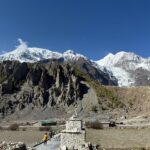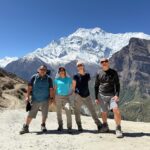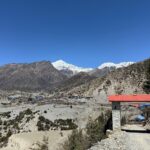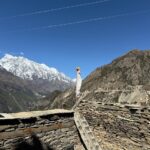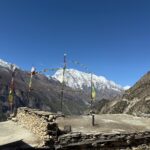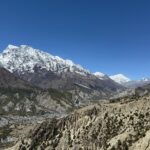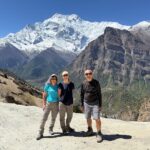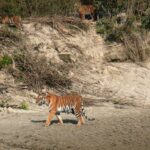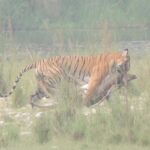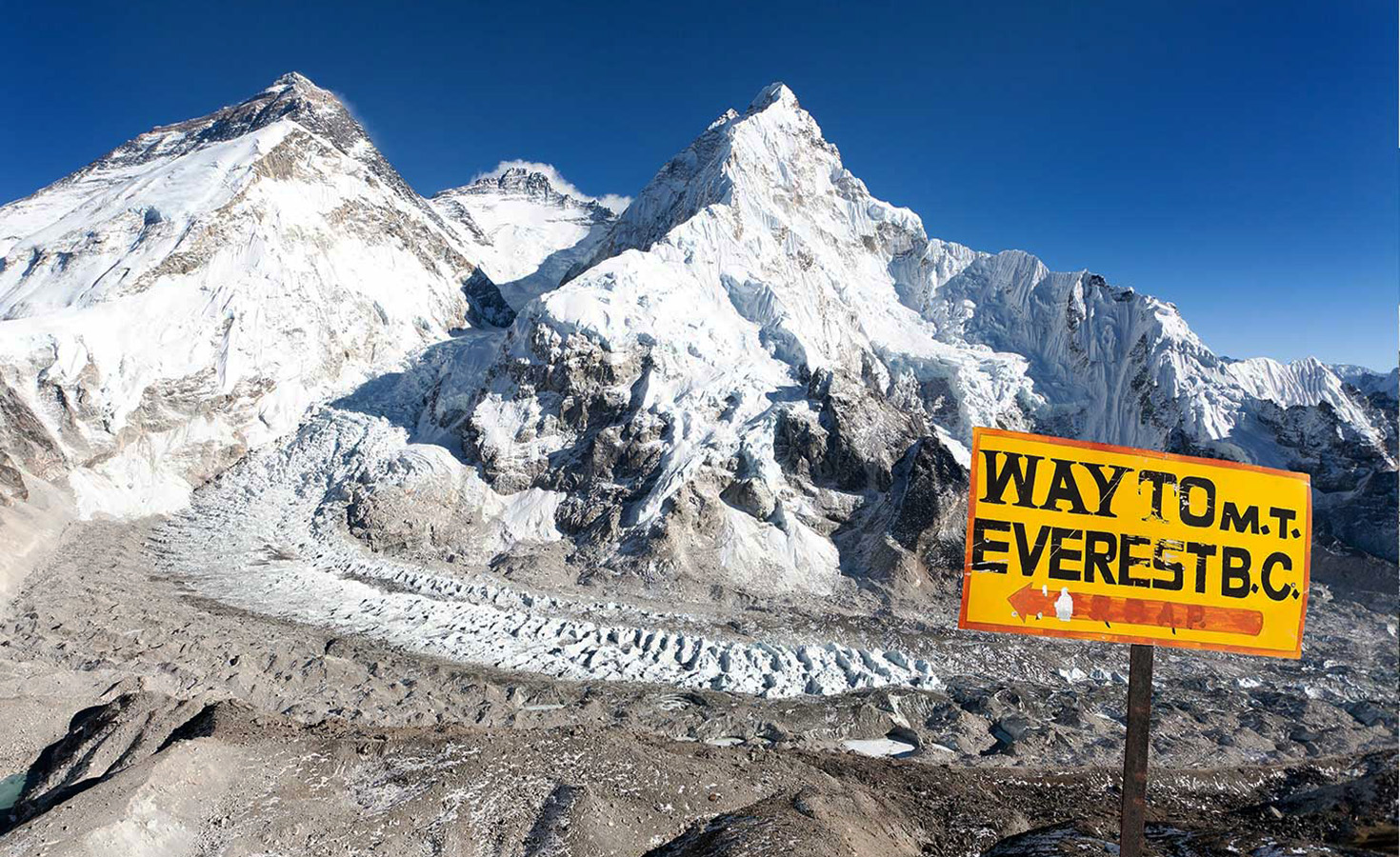
Everest Base Camp Group Trek
Everest Base Camp (EBC) group trekking is an organized trekking adventure where individuals join a group to trek to the base of the world’s highest peak, Mount Everest (8,848m). It follows a well-established route through the Khumbu region, passing scenic landscapes, Sherpa villages, monasteries, and breathtaking mountain views. Group trekking offers a social experience, allowing trekkers to share the journey with like-minded adventurers while benefiting from cost-sharing, professional guides, and better safety measures. This trek is perfect for those who want to experience Nepal’s unique culture, stunning landscapes, and the challenge of reaching Everest Base Camp with the support of a team.
How long does the Everest Base Camp group trek take?
The Everest Base Camp group trek typically takes 12 to 16 days, depending on the itinerary and acclimatization days. A standard itinerary includes 8-9 days of trekking to reach Base Camp and 3-4 days for the return journey, with acclimatization stops in Namche Bazaar and Dingboche. Most group treks follow a 14-day schedule, including arrival and departure days in Kathmandu. The trek covers around 130 km (round trip) with an average daily walk of 5-7 hours. Weather conditions, altitude, and group pace may affect the duration, so flexibility is important. Proper acclimatization is key to a safe and successful trek.
What is the best time of year for Everest Base Camp group trekking?
The best time for Everest Base Camp group trekking is spring (March-May) and autumn (September-November). These seasons offer stable weather, clear skies, and excellent mountain views.
- Spring (March-May): Temperatures are mild, and rhododendrons bloom, adding color to the landscape. It’s a popular season with moderate trekking traffic.
- Autumn (September-November): Crisp air, stable weather, and stunning views make it the most favored season. The trails are busier, but conditions are ideal.
Winter (December-February) is possible but very cold, with snow-covered trails. Summer/monsoon (June-August) brings heavy rainfall, poor visibility, and slippery trails, making it the least recommended season.
For the best experience, plan your trek in spring or autumn when conditions are most favorable.
How difficult is the Everest Base Camp group trek?
The Everest Base Camp trek is moderately difficult, requiring good physical fitness and endurance. It does not involve technical climbing, but the high altitude (5,364m), long daily hikes (5-7 hours), and steep ascents and descents make it challenging. The major difficulty is altitude sickness, so acclimatization days are included in the itinerary. Trekkers need to be physically prepared with cardio, strength training, and stamina-building exercises before the trek. With proper preparation, gradual pacing, and group support, most trekkers can successfully complete the journey.
What is the maximum altitude reached during the Everest Base Camp group trek?
The highest altitude reached during the Everest Base Camp group trek is 5,545m (18,192ft) at Kala Patthar, a popular viewpoint near Gorak Shep offering breathtaking sunrise views of Mount Everest.
Everest Base Camp itself sits at 5,364m (17,598ft), marking the trek’s main destination. Along the route, important high-altitude stops include Namche Bazaar (3,440m), Tengboche (3,867m), Dingboche (4,410m), and Lobuche (4,940m).
Due to the high elevation, altitude sickness is a risk, so acclimatization days in Namche Bazaar and Dingboche are crucial. Trekkers must ascend gradually, stay hydrated, and follow the guidance of experienced guides to ensure a safe and enjoyable trek.
What are the benefits of joining a group trek to Everest Base Camp?
Joining a group trek to Everest Base Camp offers several advantages:
- Cost-sharing: Group trekking is more affordable than private treks, as expenses for guides, porters, and logistics are split.
- Safety & Support: Trekking with a group ensures better safety in case of emergencies, altitude sickness, or unexpected weather changes.
- Social Experience: Meeting like-minded trekkers creates camaraderie and motivation, making the journey enjoyable.
- Professional Guidance: Experienced guides provide route navigation, cultural insights, and altitude management.
- Pre-arranged Logistics: The trek is well-organized with permits, accommodations, meals, and transport arranged in advance.
Overall, a group trek enhances safety, affordability, and the overall trekking experience while fostering lifelong friendships.
Is prior trekking experience required for the Everest Base Camp group trek?
No prior trekking experience is strictly required, but having some hiking experience can be beneficial. The trek is physically demanding, requiring good fitness and endurance. Trekkers should be comfortable walking 5-7 hours per day on varied terrain with steep ascents and descents.
If you’re a beginner, training at least 2-3 months before the trek is recommended. Focus on:
- Cardio exercises (running, cycling, swimming) for stamina
- Leg strength training (squats, lunges, uphill walking)
- Hiking practice with a backpack
Mental preparedness is also key. A positive mindset, determination, and gradual acclimatization help first-time trekkers successfully complete the journey. With proper preparation and group support, beginners can definitely achieve the Everest Base Camp trek.
What permits are needed for Everest Base Camp group trekking?
Two essential permits are required for the Everest Base Camp trek:
- Sagarmatha National Park Entry Permit – Costs NPR 3,000 (approx. $25) per person for foreigners.
- Khumbu Pasang Lhamu Rural Municipality Permit – Costs NPR 2,000 (approx. $15) per person.
These permits are checked at various points along the trail. They can be obtained in Kathmandu or at entry checkpoints. Group trekking companies usually arrange these permits in advance, making the process hassle-free.
How are meals arranged during the Everest Base Camp group trek?
Meals during the Everest Base Camp trek are provided by local teahouses along the route. These teahouses offer set menus with a variety of meals, including:
- Breakfast: Porridge, pancakes, toast, eggs, tea/coffee
- Lunch & Dinner: Dal Bhat (rice & lentils), noodles, pasta, momos, soups, and vegetable dishes
- Beverages: Tea, coffee, hot lemon, soft drinks
Food is simple but nutritious, helping trekkers maintain energy levels. Meat is not recommended at higher altitudes due to preservation concerns. Group trekking packages usually include all meals, except for extra snacks and beverages.
How much does an Everest Base Camp group trek cost?
The cost of an Everest Base Camp group trek ranges from $1,200 to $1,800 per person, depending on the trekking company, services, and group size.
Inclusions:
- Permits, guide, and porter fees
- Domestic flights (Kathmandu-Lukla-Kathmandu)
- Accommodation (teahouses)
- Meals (breakfast, lunch, dinner)
- First aid & emergency support
Exclusions:
- Personal expenses, snacks, bottled drinks
- Travel insurance
- Tips for guides/porters
Larger groups tend to have lower costs per person. Booking with a trusted trekking agency ensures quality service and a smooth trekking experience.
How do I book an Everest Base Camp group trek with a reliable trekking company?
To book a reliable Everest Base Camp group trek, follow these steps:
- Research trekking agencies – Look for licensed operators with good reviews.
- Compare packages & prices – Check inclusions, group sizes, and costs.
- Verify experience & safety measures – Ensure guides are experienced in high-altitude trekking.
- Read traveler reviews & testimonials – Platforms like TripAdvisor, Google, and Facebook provide insights.
- Contact the company – Ask about itineraries, permits, and preparation tips.
- Confirm booking with deposit – Secure your spot by making an advance payment.
Booking with a reputable company guarantees a safe, well-organized, and enjoyable trek to Everest Base Camp.

